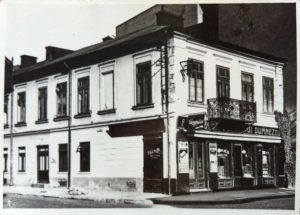There are no words to describe the absurd horror of blowing something up that was built with such delicacy and skill as the temples of Palmyra.
 Temple of Bel. 2004No situation describes the actual times better: a bunch of uneducated fanatics runs around blowing up in a matter of minutes what has been put up more than 2’000 years ago with more skill and craft than we can deliver today with modern machinery.
Temple of Bel. 2004No situation describes the actual times better: a bunch of uneducated fanatics runs around blowing up in a matter of minutes what has been put up more than 2’000 years ago with more skill and craft than we can deliver today with modern machinery.
 Great Colonnade at Palmyra, 2004.
Great Colonnade at Palmyra, 2004.
Actually, it’s all about looking for hidden treasures to fund warfare and making it look like religious zeal.
The powerful nations keep away, it’s about antiques and therefore not their (democracy-spreading) business. The residents, intimidated and destabilised, begin fleeing towards those very democratic countries, whose governments are then taken aback and don’t know how to react.
 A July morning in 2004, 6am
A July morning in 2004, 6am
Memories of walking down those majestic streets 22 m wide ten years ago and passing the imposing walls and columns 12m high almost choke me now. I had hoped to come back one day in a month other than July.
Until May 2015, all people passing had respected the work of the ancients.
The sands would have taken better care of the ruins, had they never been retrieved from it.
 The amphiteatre, 2004. 20 people were shot here in May 2015. Ten times more were killed until August, at least one third were civilians..
The amphiteatre, 2004. 20 people were shot here in May 2015. Ten times more were killed until August, at least one third were civilians..
There is nothing to go back to. Gone are the marvels now. Their guardian died trying to save them from looting and destruction. The valiant head of Antiquities Department in Palymra for 50 years, Khaled al-Asaad, 82, was captured, interogated about hidden treasures for one month and then, for his refusal to cooperate, beheaded last August in front of the very ancient stones he was trying to protect.
Do stop using the word ‘execution’ for similar acts: there is no ‚lawful penalty’ or ‚state’ or ‚trial’ linked with this kind of attrocity. It is murder.
 Altar. Temple of Baalshamin, built in 131AD. 2004.
Altar. Temple of Baalshamin, built in 131AD. 2004.
What happened since last August? The loathed bunch of freaks finances its existence by selling loot. I wonder who’s buying. And who keeps selling dynamite to creatures which ruin in one day what took years to accomplish and stood there for 2’000 years.
 A lizard hiding in the altar wall, 2004
A lizard hiding in the altar wall, 2004
Once, under Queen Zenobia, this was a place of both power and tolerance, where different eastern and western cultures interacted. Not even the Mongolian Timurids dared to destroy what survived from the Neolithic times and what the Romans had built under Diocletian.
 Destruction in 2015. ©REUTERS/Social Media
Destruction in 2015. ©REUTERS/Social Media
Meanwhile, there are 60’000 people trying to flee from this madness – and Europe keeps debating and discussing, trying to sit it out, make it go away.
While everybody sits around yapping and bawling on overpriced devices designed in California and made in China about the rights of borderline cases in countries whose people don’t give a flying fart about what happens here.
 Jordan, Za’atari, Syrian refugee camp, 2013. 122’700 people and 5’000 coming in every day. From Wiklipedia
Jordan, Za’atari, Syrian refugee camp, 2013. 122’700 people and 5’000 coming in every day. From Wiklipedia
Places are being pillaged and there are more people on the run than after WWII – but nobody seems to care about what Syria is going through or see the great efforts Jordan, Turkey and Lebanon are making right now.
 Jordan, Za’atari refugee camp, opened 2012, fourth largest in the world. Photo: Brian Sokol / UNHCR
Jordan, Za’atari refugee camp, opened 2012, fourth largest in the world. Photo: Brian Sokol / UNHCR
So many lies everywhere. These are dark times and the end is nowhere near in sight. Let us please at least stop lying to ourselves.
 The way in. ©The Economist from August 29th
The way in. ©The Economist from August 29th
Later edit, November 12th, 2015. The refugees are in Europe. Almost everywhere. Not in Romania, where there’s nothing much for them to be found except animosity and poverty.
In generous Germany’s harbours there are 80’000 people waiting for something. And winter’s coming.






 Today I helped grandma out with the Christmas tree. I climbed up the ladder and got the box with the decorations down from the top shelf. The box!… one more piece that survived from the pharmacy!
Today I helped grandma out with the Christmas tree. I climbed up the ladder and got the box with the decorations down from the top shelf. The box!… one more piece that survived from the pharmacy!

 narrator -noun:
narrator -noun: